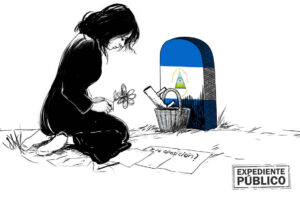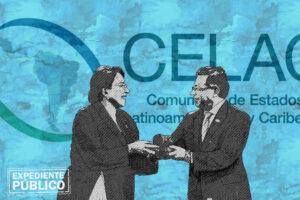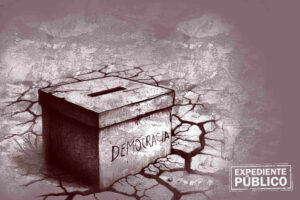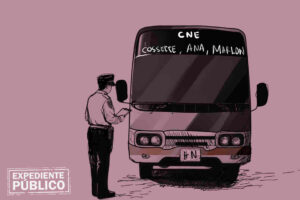Expediente Público
In 2010, a few years after Daniel Ortega had returned to power in Nicaragua, mestizo settlers began an uncontrolled expansion into the autonomous regions of the Caribbean, the cradle and habitat of indigenous and Afro-descendant peoples.
Human rights reports on the situation in the region have shown that over the last decade, the arrival of these settlers to indigenous and Afro-descendant territories has involved murders, kidnappings, rapes, armed attacks, extortion, threats, and a permanent climate of insecurity.
Although indigenous lands have been the spoils of the wars of conquest for five centuries, the Miskito of Nicaragua, the main indigenous group in the country, had always managed to hold onto their territory. The arrival of farmers, ranchers and artisanal miners from north, central and Pacific Nicaragua that began in 2010 threatens the survival of their culture and ancestral way of life.
Marisela Joseph, a Miskito mother from Esperanza–Río Wawa summarizes the situation in her territory: “The mestizos have totally destroyed our natural resources. Here near our community we have our fences, up to there; from there on we have nothing, there is no land, there are no trees, there is nothing. And this is a problem, but the biggest problem here is that the mestizos came out and murdered many people. My father was kidnapped and then killed, along with a brother-in-law. Here in my community they have murdered eight people, I think.”
Marisela’s father Francisco Joseph was kidnapped by settlers in December 2015, in an attack on the Esperanza–Río Wawa community. He has since disappeared, but his family is certain that he was murdered.
Settler crimes go unpunished
Crime and insecurity in the indigenous territory has led to some 49 indigenous people being killed between 2011 and 2020 due to land conflicts with settlers. Currently a thousand of them have been displaced to cities of the north Caribbean region of Nicaragua and even Honduras, according to a report by the Center for Justice and Human Rights of the Atlantic Coast of Nicaragua (‘Cejudhcan’ in Spanish).
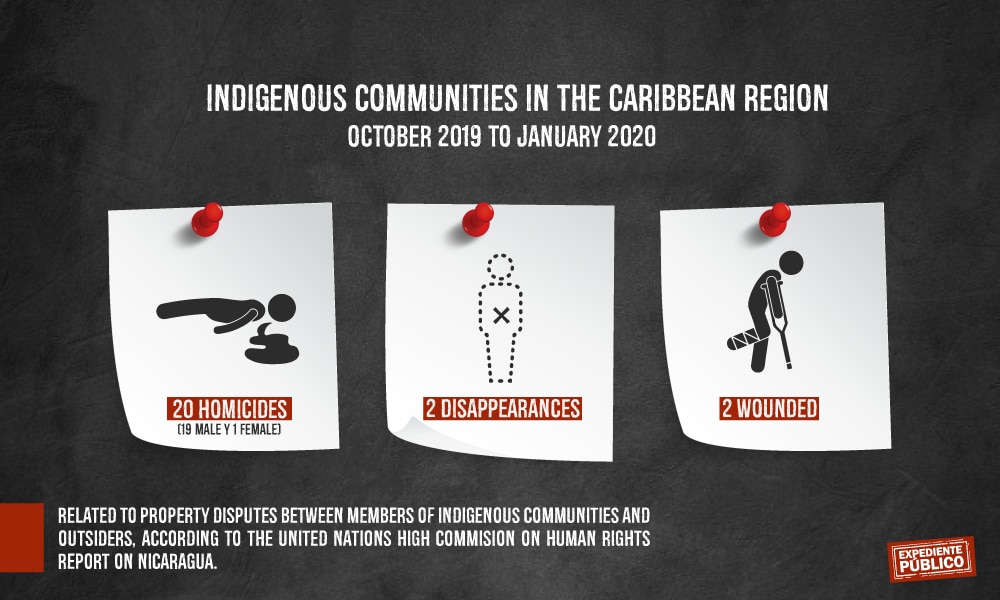
From October 2019 to January 2020, the Nicaraguan National Police recorded 20 homicides (19 men and 1 woman), two disappearances, and two cases of injury related to property conflicts between members of the indigenous communities and outsiders in the North Caribbean region, states the Report of the United Nations High Commissioner for Human Rights on Nicaragua, published February 25, 2021.
The report, titled “A year of violence against those who defend the rights of the Mayangna and Mískitu indigenous peoples” by Cejudhcan, the Nicaraguan Center for Human Rights (Cenidh), the Legal Assistance Center for Indigenous Peoples (Calpi) and the Observatory for the Protection of Human Rights Defenders, states that in 2020 there were thirteen murders of indigenous community members, eight injured in armed attacks, two kidnappings, the forced displacement of one community (most of them members of the Mayangna indigenous people) and two attacks on Miskito girls.
Indigenous people in the Twi Yahbra and Tasba Raya territories claim that there are military weapons among the settlers, identifying AK, UZI, M-16 and AR-15 rifles.
“You can see that these gangs going around in the Caribbean region have military training; they enter and leave an area very quickly, they have the elements to be considered paramilitary groups at the service of landowners and agricultural businesses,” says Juan Carlos Ocampo, a member of the Prilaka indigenous organization.
Barely ten minutes upstream on the Wawa River by dugout canoe, the settlers may be firing their military weapons and hunting rifles, Marisela Joseph, an indigenous person from La Esperanza, tells Expediente Público.
The indigenous people are surprised that no state authority, not even the army or the police, places limits on the settlers, who are acting like gangs of land-grabbers and even go around with military weapons, while the Miskito are not even allowed to purchase ammunition for hunting.
More on repression in Nicaragua: Repression Against Women: The Regime’s Anti-Feminist Efforts in Nicaragua
It could be worse and it was worse
Álvaro Lesting Mccoy lost his farm in 2013. When he returned from some errands in Bilwi, he found his crops destroyed. The following year he returned to his land and found a man there with a boy about eight years old, marking his land as plot 30.
He returned a year later and found a group of people, mostly children, along with an adult who had bought the land for 15,000 cordobas, about $540 for 21 hectares.
In 2015, the community members met to try to negotiate the departure of the settlers who were taking more land, but the leader of the settlers, identified as Polo Pérez, entered the Wisconsin community with 30 armed men.
The Francia Sirpi community, in turn, disintegrated after 2015. Many of its members went to Waspán, others to Bilwi, and others moved to the main village.
Ruins of two of the houses burned in the 2015 attack are still there. The foundation of one of the burnt houses is ironically close to a cell phone tower, given that the community members are not paid by the company that occupies their territory like one more settler.
The invading settlers have gotten as far as taking over the farms west of the Wawa River, so Francia Sirpi has already lost access to this important corridor and has been left with practically no farmland; this was confirmed by Expediente Público.
“As of 2015 (the land grabs) have started to become more violent. On December 27 (of that year), three families were working on their land and 85 armed settlers arrived, abducted three men and let the women and children go,“ says Gonzalo Richard Lacayo, the “whista” of La Esperanza–Río Wawa, as the Miskito call their judges or community leaders.
“We know there is danger, at any moment they could attack us; we have no way to resist, we cannot take the risk because they could kill us, we are cornered in our community,” says Richard Lacayo.
In October 2015, the Wangki Twi–Tasba Raya communities received precautionary measures granted by the Inter-American Commission on Human Rights (IACHR). This did not prevent continued attacks on indigenous villages by settlers in late 2015.
The Miskito of Tasba Raya have lost all their farmland; that is, 21,000 hectares, to the invasions, says Amador Francis Davis, the “whista” of Francia Sirpi.
The invasions began to increase in 2018 and the latest was on January 17, 2021, when settlers were detected at the edge of the village. Twenty minutes away from the community the new borders imposed by the settlers on the Miskito can be seen, “as if they intended to take everything, including the village,” says Francis Davis.
Forced displacement
Manuel Hernández was kidnapped from his land in the Sangni Laya community, 550 kilometers from Managua. The 12-man band of settlers was armed with rifles, shotguns, pistols and an AK rifle.
The incident occurred on September 21, 2020, in the community in the Twi Yahbra territory.
Hernández was kidnapped along with his son-in-law who was also on the land. The settlers also set fire to five indigenous houses, including the Hernández home, so the entire community moved to Bilwi. As of September 3 there were 30 refugee families living there due to threats and incursions by the invaders. For several weeks Sangni Laya was a ghost town until the community members decided to return, starting in November 2020.
Read more: Nicaragua’s Judiciary: Subordinate to the Ortega-Murillo Regime
The presence of dozens of displaced families in Bilwi, the regional capital, prompted the police to act. One of the settler kidnappers, Delvin Martínez, was caught and sentenced, but his sentence will be no more than three years in prison. This is unusual for these repeated cases, according to several community leaders.
To the whista or community judge of Sangni Laya, Jaime Meza, freeing the settler would have meant that “next time the kidnap victims will not get out alive.”
How the land is appropriated
Land in the indigenous territories cannot be sold or transferred. The deed is held in the name of the community and the fields are worked according to the traditional portioning out of the land per family, but they can be leased.
Renting out a plot is a decision made by the Communal Assembly, according to Bill 445 approved in 2003, the Law of the Communal Property Regime of Indigenous Peoples and Ethnic Communities of the Autonomous Regions of the Atlantic Coast of Nicaragua and the Bocay, Coco, Indio and Maíz Rivers.
The settlers engage in illegal purchases or leases, taking advantage of the corruption of some territorial, community and municipal authorities, as well as extortion, blackmail and violence against community members whom they intimidate into giving them permission to use their farms.
One of the settler leaders, who prefers not to give his name, says: “By the peaceful route, anything is possible; talking with them I understood myself, I have no problems with anyone.“
The settler says that he was 18 years old a decade ago when he emigrated to the municipality of Rosita, also in the North Caribbean region. Later he moved to Tungla, to the east, and is now in the Sangni Laya region.
He claims to have an endorsement from the community, issued by the whista. The collective he belongs to leases 151 hectares, which are shared by seven other related families. He says that to enter the area, he paid the territorial council the equivalent of 588 dollars for every 35 hectares at the current exchange rate and in February he has to pay some 132 dollars for every 35 hectares. He is to lease them from the community for 10 years and then they will make a new arrangement.
The settler says, “If they want me to leave and they pay me back the bills (money) that I have invested, the interest and the labor, I won’t argue with anyone, I would leave and not fight for the land.” However, Bill 455 stipulates that there is to be no compensation paid to outsiders in indigenous community territory, but that improvements in the area must be paid for by the community.
The settlers did not receive an endorsement from the council, but from a community that worked the land.
However, Emilio Taylor maintains that “they were on the land that our ancestors worked. There were 16 families and we told them they couldn’t live there anymore, but they had us frightened because they were armed and we don’t have any way to get them out by force. The family decided to rent to eight people, no more. We don’t want to do it, but we are forced to under threats.”
“The elders were angry, but a lot of land was seized without permission, only with the authorization of the territorial president and even of some community judges. I have the documents because I was the territorial vice president,” Taylor adds.
State complicity
Although the first group of settlers wanted to settle in indigenous community territories in 2004, in Awas Tingni, a town of the Mayangna ethnic group 600 kilometers from Managua, the government at the time managed to handle things so that the land invaders left. But since 2010 the land grab has been constant, and what is worse, the government itself is accused of promoting and even sponsoring the settlers.
Lottie Cunningham, the president of Cejudhcan, says that the land seizures are encouraged by the government to create a climate of impunity around the invaders’ crimes against indigenous community members, as well as to promote extractive activities in their territories such as mining and overexploitation of forestry, monocultures such as African palm and cocoa, and livestock farming.
Furthermore, “there has been no concrete action on the part of the Nicaraguan government to reduce violence, to protect the life and land of the communities,” Cunningham says.
“I relate the urge to take other peoples’ lands to the Sandinista practices of power and control. Those people take land and take the lands of others who are not their people. It is a way of exerting pressure and control, but also of paying their own people,” says Juan Carlos Ocampo, a member of the Prilaka (freedom) indigenous organization.
Solutions to the blatant humanitarian crisis
In spite of the deeding of indigenous community lands, the departure of outsiders from indigenous, Afro-descendant and special territories is the last of the five phases of the territorial demarcation imposed by Bill 445. This is why it is the communities’ main demand.
Cunningham explains that “when we speak of reclaiming, the natural or legal persons that are illegally occupying these lands will have to vacate or abandon the land so that the indigenous communities can have the use, occupation and control of their territories, but the Nicaraguan government has omitted this last phase.”
In the words of Marisela Joseph, “What I can tell you is what anyone in the community would tell you: the first thing is the land, the source of our life, and we do not have access to it. Without it we are nothing; right now, for example, to take a fish out of the river we cannot go any farther, because the person who passes the boundary is persecuted, besieged, attacked and has to run like an animal to get back to the community.”
But the problem of property in the Caribbean region is no longer a primarily legal situation. Various community leaders who were interviewed are clear that due to the lack of land for farming or hunting, the indigenous people’s livelihood has been lost.
The parish priest of Waspán, Rodolfo French, recalls that in addition to the land problem, the people face the aftermath of two hurricanes that hit the region in November 2020. “This warns us that a serious famine is coming in May, June and July, which are very hard months along with the winter,” he emphasizes.
